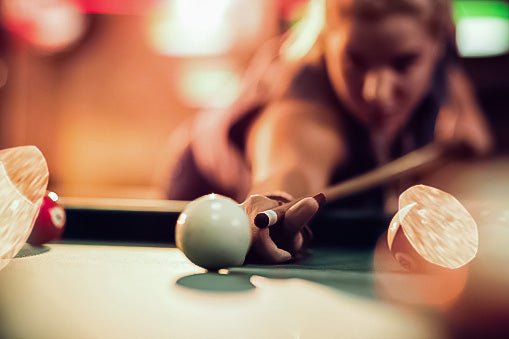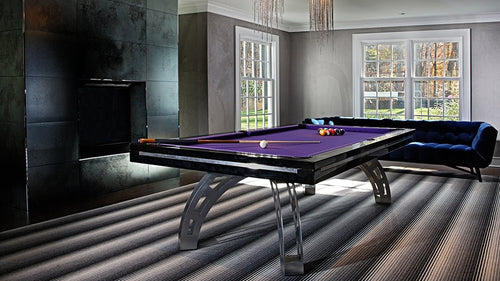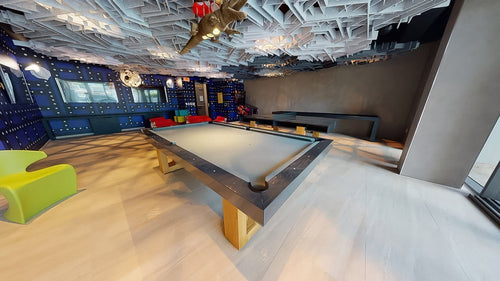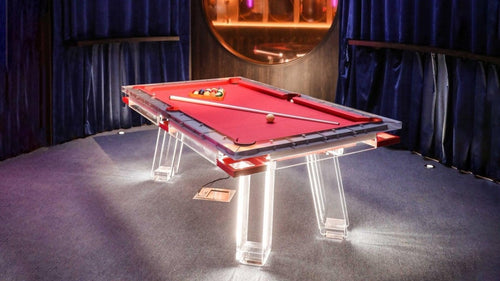Enjoy our modern designs
Over 200 Fascinating Facts About Pool Tables and Billiards
Billiards, pool, snooker—these games have entertained players for centuries, shaping everything from royal courts to modern bars. Below, you’ll find an extensive list of over 200 intriguing facts, spanning the game’s medieval origins, technological innovations, and modern cultural impact. Whether you’re a casual player or a dedicated enthusiast, these tidbits are sure to deepen your appreciation for the rich world of cue sports.
1–100: Classic and Quirky Billiards Facts
1. Billiards was first played in the 15th century in Northern Europe.
2. It was originally an outdoor lawn game similar to croquet, later moved indoors.
3. The first recorded billiard table was owned by King Louis XI of France in 1470.
4. The term "pool" comes from a 19th-century betting pool where people bet on horse races. Billiard rooms often doubled as betting parlors, so the game became known as "pool."
5. The cue stick was invented in the late 1600s when players began to use the narrow end of the mace, a device used to shove the balls rather than strike them.
6. The phrase "behind the eight ball" comes from the game of 8-Ball when a player's ball is blocked by the 8-ball.
7. The balls were initially made from wood and clay. Ivory was later used, but due to the endangered elephant population, it was replaced with synthetic materials.
8. The 1st coin-operated billiard table was patented in 1903.
9. Pool tables are usually covered with green cloth to represent the green lawn where the game was originally played.
10. The rails of pool tables are made from gum or synthetic rubber for consistent, predictable rebounds.
11. The longest recorded streak of consecutive pool games won is 526, achieved by Willie Mosconi in 1954.
12. Pool and billiards are not the same—pool is a game played on a pocket billiards table, while "billiards" can refer to various games played on a table without pockets.
13. Pool tables come in different sizes, typically 7, 8, or 9 feet long.
14. Billiard balls were originally sized according to the species of animal from which the ivory was harvested.
15. Billiards and pool games were once considered immoral and were banned in certain places.
16. Women were forbidden from playing pool in public in the U.S until the early 20th century.
17. There are over 30 different official billiard games.
18. Snooker, another cue sport, was invented in India by British Army officers.
19. The largest pool tournament in the world, the BCA Pool League World Championships, sees around 500 tables set up for players.
20. Pool tables need to be leveled accurately for a fair game. Even a slight tilt can cause the balls to roll off course.
21. Early versions of billiard cloth were made from a blend of wool and camel hair.
22. Bugatti's $2.6 million pool table is touted as the world's most expensive. The self-leveling table uses computer technology to remain stable, even on a yacht.
23. The playing surface of a pool table is typically made of quarried slate.
24. A pool table can weigh up to 1,000 pounds or much more if it’s a larger traditional snooker table.
25. The record for the most balls potted in one minute is 34!
26. Professional pool players can make the cue ball travel at speeds of up to 32 km/h (20 mph).
27. The first billiard room was built in England in 1765.
28. Pool halls were popular gathering places during the American Prohibition era.
29. There's a billiard game called "Baseball Pocket Billiards," incorporating rules from America's oldest pastime sport.
30. The first official World Professional Billiards Championship was held in 1873.
31. Michael Phelan, called the “father of American billiards,” wrote the first book on billiards in 1850.
32. The first 8-Ball pool was invented around 1900.
33. The 8-Ball game is also known as "stripes and solids" or "spots and stripes" in the UK.
34. In a professional match, referees often wear gloves to avoid transferring oils and dirt to the billiard balls.
35. The popular movies "The Hustler" (1961) and "The Color of Money" (1986) revived interest in pool in the U.S.
36. Babe Cranfield holds the record for the most consecutive pool balls pocketed without a miss—2,400.
37. Billiard chalk, like chalk in weightlifting, increases friction between cue ball and cue tip for better control.
38. Billiard cloth is usually vacuumed or brushed with a special brush to remove chalk dust and debris.
39. Before cloth-covered tables, billiards was played on a flat stone surface.
40. There's a cue sport called "Artistic Pool," focused on elaborate trick shots.
41. Billiards was one of the first sports to have a world championship, in 1873.
42. The earliest pool balls made of ivory led to the slaughter of up to 12,000 elephants a year.
43. There's a pocketless version of billiards called "three-cushion billiards," played with just three balls.
44. In many pro tournaments, players must wear a vest and bow tie.
45. In straight pool, the first player to 100 points wins.
46. Different cue sticks exist for specific shots: break cues, jump cues, snooker cues, etc.
47. Pool and billiards survived many puritanical bans on games in 19th-century America.
48. The "rack" for setting up balls is usually triangular; diamond-shaped racks are for 9-ball.
49. Early billiard cues had metal tips, later replaced with leather for more spin capability.
50. The white ball is referred to as the cue ball.
51. A standard billiard set has 15 object balls plus one cue ball.
52. "Scratch" in pool means the cue ball is pocketed.
53. Pool tables are built at a 2:1 length-to-width ratio.
54. Historically, some pool tables had grand canopies to display their prestige.
55. Professional-quality tables often use a single piece of slate for the best roll consistency.
56. George Washington famously enjoyed playing billiards.
57. Early billiards was often played by nobles and royalty.
58. In 1588, the Catholic Church deemed playing pool a sin.
59. Billiards was the first sport to undergo formal rule standardization.
60. King Louis XIV of France was a big billiards aficionado.
61. Steel billiard rails were introduced in the 19th century for consistent rebound.
62. English billiards predated pool and snooker.
63. WPA (World Pool-Billiard Association) governs international pocket billiards.
64. Modern pool likely evolved from "Sfere De Tavolo," played in 15th-century Italy.
65. Pool is called “billar” (Spanish), “billard” (French), “bilard” (Polish), “biliárd” (Hungarian), and “bilyard” (Russian).
66. The heaviest ball used in a pro game weighed 7.5 kg (16.5 lbs).
67. Snooker demands players pocket balls in precise sequences, raising difficulty.
68. Pro tournaments heat the balls to reduce moisture and ensure consistent roll.
69. Cue chalk emerged in the 1800s to prevent slipping off the cue ball.
70. The first plastic/phenolic resin pool balls appeared in the 1920s.
71. Each stripe and solid pair (1 & 9, 2 & 10) adds up to 10.
72. Traditional Snooker uses 21 balls: 15 reds plus six others.
73. A perfect snooker break is 147 points.
74. Mark Selby holds the record for most snooker centuries at 776.
75. "Cue" originates from the French "queue," meaning tail.
76. The term "queue" also means "line," referencing players awaiting their turn.
77. Circular or zig-zag pool tables exist but aren’t used professionally.
78. "Poolhall Junkies" (2002) is a cult favorite among billiards enthusiasts.
79. "Straight Rail" billiards scores points by causing the other two balls to contact the rails.
80. Claude Shannon, a famous mathematician, built a computer to simulate billiards.
81. The World Straight Pool Championship dates back to 1912, making it the longest-running pool tournament.
82. Table cushions or "rails" are designed for consistent rebounds.
83. A "jump shot" uses a special technique to hop the cue ball over an obstacle.
84. The first women's world snooker championship took place in 1976.
85. Wolfgang Amadeus Mozart was fond of billiards.
86. Older tables had vertical side rails only to keep balls from rolling off.
87. A well-cared-for pool table can easily last a century.
88. People of all ages enjoy billiards, making it a lifelong sport.
89. Billiards, pool, and snooker are distinct games, and the terms aren't interchangeable.
90. A "Masse shot" involves high spin and a steep cue angle to curve the cue ball.
91. The cue ball is often larger in bar/pub tables for mechanical ball return systems.
92. Re-chalking the tip before every shot enhances grip and control.
93. Gambling on billiards led to the creation of a “pool”—a betting term now linked to the game.
94. 19th-century Americans called billiards a "gentleman's game," favoring calm, controlled play.
95. A "kiss shot" is when the cue ball deflects off another ball and pockets it.
96. The U.S. Open 9-Ball Championships is America’s most prestigious professional tournament.
97. Leather cue tips are the most common type today.
98. Jean Balukas was the first woman to compete professionally in a men’s pool tournament.
99. Pool tables are often found in rec rooms, bars, or clubs worldwide.
100. Some schools include billiards in their physical education curricula.
101–200: New Tidbits to Double the Fun
101. Variations of pool exist globally, each with unique local twists and rules.
102. Standardized colors and numbers ensure fairness across many pro tournaments.
103. Pro snooker tables use a special “baize” green for optimal visibility.
104. A modern adult pool cue is generally 57–59 inches long.
105. Europe hosts prestigious billiards championships drawing global contenders.
106. Carom billiards, common in Europe, is played on pocketless tables with three balls.
107. Cue ball physics involve friction, spin, and precise angles—complex but captivating.
108. Cue-tip hardness significantly affects shot accuracy and spin.
109. Different brands of cue chalk can subtly influence gameplay feel.
110. High-end or custom cues are status symbols among top players.
111. The IOC has considered adding cue sports to the Olympic program multiple times.
112. Elite players train for hours daily, honing their stance, stroke, and aim.
113. Historic pool halls showcase local culture through art, architecture, and tradition.
114. The largest pool table ever built resides in a Belgian museum as functional art.
115. High-speed cameras reveal the explosive force behind a well-struck break.
116. Rack formations at the start of a game aim to ensure fairness and complexity.
117. Materials science breakthroughs create lighter, stronger pool cues.
118. The 1960s saw a major revival in pool, spurred by iconic films and cultural shifts.
119. Modern pool halls may feature automated table-leveling for perfect play surfaces.
120. Luxury pool tables can include custom inlays, engravings, and exotic materials.
121. Many champions use mental exercises—visualization, focus drills—to stay sharp.
122. Venues like New York's “Amsterdam Billiards” have achieved legendary status.
123. Mastering “angle of incidence” and “reflection” is crucial for advanced shots.
124. Some players use simulation software to refine shot angles and strategies.
125. Table pockets have evolved to ensure consistent drops and balanced difficulty.
126. Certain cutting-edge tables feature real-time shot analysis via built-in sensors.
127. Tournaments apply strict table and equipment standards for fairness.
128. The break shot is among the most practiced and thrilling moves in pool.
129. Banking shots off the cushion test a player’s geometry and precision.
130. Referees in pro matches monitor every detail to enforce rules stringently.
131. "Russian Pyramid" is a distinct, challenging version of billiards popular in Eastern Europe.
132. Outdoor pool tables, built with weather-resistant materials, are a modern trend.
133. Pool table construction parallels major innovations in woodworking and metalcraft.
134. Vintage cues and tables are prized by collectors worldwide.
135. Teachers sometimes use pool to demonstrate physics principles like momentum.
136. Cue sports have inspired numerous console games, mobile apps, and VR titles.
137. Many players enter national events via smaller local qualifying rounds.
138. Ergonomic pool cues help reduce strain during lengthy matches.
139. Some local "pool sharks" become minor celebrities for their talent and flair.
140. Pool’s precision parallels golf, where micro-miscalculations significantly impact outcomes.
141. Marathon tournaments test endurance, sometimes running hours on end.
142. Modern table designs demand less upkeep thanks to advanced engineering.
143. Studying an opponent’s style is a core strategy in top-level play.
144. Pool halls appear in films and art, symbolizing both relaxation and fierce competition.
145. Regular professional cleaning is essential for peak table performance.
146. Many players have pre-shot routines and superstitions they follow rigidly.
147. Pool is a community-building pastime in many countries worldwide.
148. The phrase “shooting pool” appears in literature, film, and music.
149. Custom-built cues can reflect a player’s personality and playing style.
150. Private clubs sometimes host exclusive tournaments for select members.
151. Some modern tables include LED lights for a stylish night-time ambiance.
152. Adjustable table legs ensure level surfaces, even on slanted floors.
153. In some communities, pool is used to bridge social gaps and resolve disputes.
154. Collegiate teams now compete in recognized national pool championships.
155. Innovations in golf and tennis often inspire advanced equipment in cue sports.
156. Dedicated training centers teach both beginners and veterans advanced skills.
157. Charity tournaments are common, merging competition with fundraising.
158. Some nations regard historic tables as cultural heritage, preserving them carefully.
159. Cutting-edge rail technology occasionally borrows from military-grade engineering.
160. Combining physics, strategy, and a dash of mental warfare defines top-tier pool.
161. Applying “English” spin is one of the game’s most intricate tricks to learn.
162. Pool leagues thrive on every continent, showcasing global talent.
163. Online tutorials revolutionize how newcomers pick up the basics of cue sports.
164. Robot training aids can simulate match conditions for practice sessions.
165. The evolution of table-making traces back centuries of craft and innovation.
166. Distinct style differences exist between European and American pool techniques.
167. Business experts sometimes liken strategic planning to a game of pool.
168. High-stakes matches now feature real-time analytics and commentary.
169. Many halls exhibit local art and memorabilia, blending culture with gameplay.
170. Pool’s blend of dexterity and tactics draws in both casual and competitive players.
171. Some tables have hidden compartments for cue and accessory storage.
172. Augmented reality tools are emerging for interactive, on-screen pool training.
173. Blessing or tapping a cue might be a lucky ritual for certain pros.
174. Pocket design is key to regulating ball drop velocity and control.
175. Prize pools at major events can be significant, fueling intense rivalries.
176. Museums worldwide celebrate the heritage of billiards and pool.
177. Many pool halls combine vintage charm with modern aesthetics for the ideal ambiance.
178. Pool transcends generations, from teen enthusiasts to seniors enjoying the game.
179. A “massé” sees the cue ball curve dramatically, thanks to steep angle and heavy spin.
180. Trick-shot exhibitions often enthrall audiences with near-miraculous precision.
181. Some pros jokingly credit cosmic luck for their best streaks and shots.
182. Academic circles sometimes integrate billiards into geometry and physics courses.
183. Pool’s unique lingo includes terms like “cut shot,” “follow shot,” and “draw.”
184. Live streaming has globalized pool, showcasing matches to fans everywhere.
185. Advanced players often plan multiple shots ahead, akin to chess on felt.
186. High-end tournaments sometimes occur at luxury resorts, merging vacation with sport.
187. Enthusiasts can spend thousands on collectibles, from vintage cues to autographs.
188. Local pool halls often host art shows, concerts, and community events, bridging social circles.
189. World champions occasionally publish strategy books revealing their insights.
190. Merging classic rules with new technology promises a bright future for cue sports.
191. Small specification changes in tables can drastically affect ball behavior.
192. Eco-friendly manufacturing is a rising trend in pool table production.
193. Professionals study match replays to tweak stance, stroke, and angles.
194. Cue sports highlight centuries of global innovation, artistry, and passion.
195. Pool is a lifestyle for many, serving as both a competitive outlet and a social pastime.
196. High-tech cues with sensors now provide instant feedback on stroke mechanics.
197. Vintage pool posters attract serious collectors and nostalgic fans.
198. Some halls run open mic nights, uniting local music culture with billiards fun.
199. Specialized workshops help novices ascend to advanced cue mastery.
200. With emerging technology and a vibrant community, the future of pool and billiards looks more exciting than ever.


















